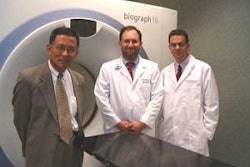Imagine being able to get away with paying only 78% of your monthly bills on time, and disregarding any late fees. Better yet, why not simply toss out 6% of those nagging bills and never have to pay them at all. If put into practice, most folks would have either their assets on the auction block or would be ducking the cover of bankruptcy protection. But for managed-care payors in the U.S., it is business as usual.
Personnel tasked with handling radiology finances for their facility or practice know they have to make timely payments for a variety of materials and services. Vendors expect to be paid regularly for the lease or purchase of equipment; consumable suppliers want to be reimbursed for products; the government wants its taxes; space owners need the mortgage taken care of each month; and the staff absolutely, positively must collect their wages and salaries.
But when it comes to getting what a center or department is due from its managed-care clients, the term "prompt" is often oxymoronic. A timely collection of payment due from clean claims submitted to U.S. healthcare insurers happens slightly less than four out of five times, according to a recent study in the American Journal of Roentgenology (July 2004, Vol. 183:1, pp. 3-7).
According to the lead author on the study, Dr. Lawrence Swayne from the department of diagnostic radiology at Morristown Memorial Hospital and Morris Imaging Associates in Morristown, NJ, the issue of prompt payment has become prominent in managed-care reform.
"Payment abuses have become so widespread that prompt-payment laws have been enacted in 47 states. Despite these efforts, our study suggests that managed-care companies may pocket close to $20 billion per year for unpaid claims at the expense of U.S. physicians," he said. Swayne and his team analyzed the compliance of payors in New Jersey with prompt-payment legislation in a previous study (AJR, July 2002, Vol. 179:1, pp.21-25).
For his current study, Swayne looked closely at the costs to radiologists related to the non-payment of claims.
His group analyzed 48,217 claims submitted in February, June, and October 2000 to six payors, representing 71.5% of the New Jersey managed-care market: Aetna, CIGNA, Horizon Blue Cross Blue Shield of New Jersey, Oxford, Prudential, and U.S. Healthcare. The claims were categorized as unpaid if they were not reimbursed 170 days after submission; timely if they were paid within 40 days of submission; or late if paid between 40 and 170 days of submission.
The claims were submitted on behalf of 11 New Jersey radiology practices by Dominion Medical Management, a Milwaukee-based third-party billing company. These practices comprised 93 radiologists, representing approximately 15% of the practicing radiologists in New Jersey, according to the authors.
All groups filed claims both electronically (61%) and by mail (39%). The researchers considered an account paid even if only partial payment was received from the payor. The group excluded capitated patients from the study.
New Jersey enacted its prompt-payment legislation on December 28, 1999. The Prompt-Pay Act specifies that payment is required within 30 days of electronic submission and 40 days for non-electronic submission. Late-payment penalties are calculated at a simple interest rate of 10% and are supposed to accompany reimbursement.
Swayne and his team defined a clean claim as "one without defect or need for any substantiating documentation that might prevent timely payment." They subdivided disputed claims into payor fault, provider fault, and no fault. They then matched the payment histories of the six payors for timeliness of payment against a 90% on-time payment standard.
The group noted that its overall clean-claims filing rate was 97%. Of the 368 disputed claims, 201 were paid late and 167 were never paid. Among claims paid late, the average time for reimbursement after the 40-day cutoff period was 75.4 days. The overdue penalty for these late claims was calculated at $5,664.
The average percentage of unpaid claims for the three-month period ranged from a low of 4% (Prudential) to a high of 9% (CIGNA). For the six payors overall, unpaid claims represented 6% of the total clean claims submitted. This amounted to a total of $106,000 for the dataset.
"The overall percentage of claims paid in a timely fashion by the six payors was 72%, and the overall average time to payment was 31 days," the authors wrote. In fact, none of the payors paid claims in compliance with the New Jersey Prompt-Pay Act.
Because radiology is a referral-based practice, has broad exposure to managed care, and interacts with a wide variety of physician practices, the researchers suggested that the applicability of their data has the potential to be extrapolated across U.S. medical practice.
"The magnitude of the financial loss from unpaid claims on a national level can be estimated as follows: We found managed-care payors failed to pay 6% of claims," they wrote. "The total payments to physician practices in the U.S. were $314 billion in 2001 (latest data available). At 6% of that amount, the loss from unpaid claims would be almost $20 billion."
By Jonathan S. Batchelor
AuntMinnie.com staff writer
August 6, 2004
Related Reading
High-tech rad therapy hospitals face lower reimbursement, May 25, 2004
Medicare database shows cardiologists driving up imaging costs, January 9, 2004
Billing for VC: even the reimbursement is virtual, November 19, 2003
Billing mistakes cost Medicare $11.6 billion, U.S. says, November 17, 2003
Prompt payments elusive for NJ radiologists, July 18, 2002
Copyright © 2004 AuntMinnie.com



















